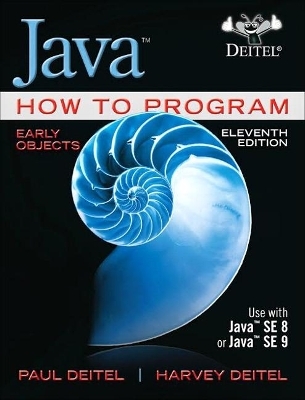
Java How to Program, Early Objects Plus MyLab Programming with Pearson eText -- Access Card Package
Pearson
978-0-13-480027-1 (ISBN)
- Titel ist leider vergriffen;
keine Neuauflage - Artikel merken
Used books, rentals, and purchases made outside of Pearson
If purchasing or renting from companies other than Pearson, the access codes for MyLab Programming may not be included, may be incorrect, or may be previously redeemed. Check with the seller before completing your purchase.
For courses in Java programming
This package includes MyLab™ Programming.
Unparalleled breadth and depth of object-oriented programming concepts
The Deitels’ groundbreaking How to Program series offers unparalleled breadth and depth of programming fundamentals, object-oriented programming concepts and intermediate-level topics for further study. Java How to Program, Early Objects, 11th Edition, presents leading-edge computing technologies using the Deitel signature live-code approach, which demonstrates concepts in hundreds of complete working programs. The 11th Edition presents updated coverage of Java SE 8 and new Java SE 9 capabilities, including JShell, the Java Module System, and other key Java 9 topics. [Java How to Program, Late Objects, 11th Edition also is available.]
Personalize learning with MyLab Programming.
MyLab™ Programming is an online learning system designed to engage students and improve results. MyLab Programming consists of a set of programming exercises correlated to the programming concepts in this book. Through hundreds of practice problems, the system automatically detects errors in the logic and syntax of their code submissions and offers targeted hints that enable students to figure out what went wrong—and why. MyLab Programming improves the programming competence of beginning students who often struggle with the basic concepts and paradigms of popular high-level programming languages. For instructors, a comprehensive gradebook tracks correct and incorrect answers and stores the code inputted by students for review.
0134800273 / 9780134800271 Java How to Program, Early Objects Plus MyLab Programming with Pearson eText -- Access Card Package, 11/e
Package consists of:
0134743350 / 9780134743356 Java How to Program, Early Objects
0134752120 / 9780134752129
MyLab Programming with Pearson eText -- Access Code Card -- for Java How to Program, Early Objects
Students can use the URL and phone number below to help answer their questions:
https://support.pearson.com/getsupport/s/
800-677-6337
Paul J. Deitel, CEO and Chief Technical Officer of Deitel & Associates, Inc., is a graduate of MIT and has over 35 years of experience in computing. He holds the Java Certified Programmer and Java Certified Developer designations, and is an Oracle Java Champion. Through Deitel & Associates, Inc., he has delivered hundreds of programming courses worldwide to clients, including Cisco, IBM, Siemens, Sun Microsystems (now Oracle), Dell, Fidelity, NASA at the Kennedy Space Center, the National Severe Storm Laboratory, White Sands Missile Range, Rogue Wave Software, Boeing, SunGard Higher Education, Nortel Networks, Puma, iRobot, Invensys and many more. He and his co-author, Dr. Harvey M. Deitel, are the world’s best-selling programming-language textbook/professional book/video authors. Dr. Harvey M. Deitel, Chairman and Chief Strategy Officer of Deitel & Associates, Inc., has over 55 years of experience in computing. Dr. Deitel earned B.S. and M.S. degrees in Electrical Engineering from MIT and a Ph.D. in Mathematics from Boston University—he studied computing in each of these programs before they spun off Computer Science programs. He has extensive college teaching experience, including earning tenure and serving as the Chairman of the Computer Science Department at Boston College before founding Deitel & Associates, Inc., in 1991 with his son, Paul. The Deitels’ publications have earned international recognition, with more than 100 translations published in Japanese, German, Russian, Spanish, French, Polish, Italian, Simplified Chinese, Traditional Chinese, Korean, Portuguese, Greek, Urdu and Turkish. Dr. Deitel has delivered hundreds of programming courses to academic, corporate, government and military clients.
Brief Contents
Introduction to Computers, the Internet and Java
Introduction to Java Applications; Input/Output and Operators
Introduction to Classes, Objects, Methods and Strings
Control Statements: Part 1; Assignment, ++ and -- Operators
Control Statements: Part 2; Logical Operators
Methods: A Deeper Look
Arrays and ArrayLists
Classes and Objects: A Deeper Look
Object-Oriented Programming: Inheritance
Object-Oriented Programming: Polymorphism and Interfaces
Exception Handling: A Deeper Look
JavaFX Graphical User Interfaces: Part 1
JavaFX GUI: Part 2
Strings, Characters and Regular Expressions
Files, Input/Output Streams, NIO and XML Serialization
Generic Collections
Lambdas and Streams
Recursion
Searching, Sorting and Big O
Generic Classes and Methods: A Deeper Look
Custom Generic Data Structures
JavaFX Graphics and Multimedia
Concurrency
Accessing Databases with JDBC
Introduction to JShell: Java 9’s REPL
Chapters on the Web
Operator Precedence Chart
ASCII Character Set
Keywords and Reserved Words
Primitive Types
Using the Debugger
Appendices on the Web Index Online Chapters and Appendices
Swing GUI Components: Part 1
Graphics and Java 2D
Networking
Java Persistence API (JPA)
JavaServer™ Faces Web Apps: Part 1
JavaServer™ Faces Web Apps: Part 2
REST-Based Web Services
(Optional) ATM Case Study, Part 1: Object-Oriented Design with the UML
(Optional) ATM Case Study, Part 2: Implementing an Object-Oriented Design
Swing GUI Components: Part 2
Java Module System and Other Java 9 Features
Using the Java API Documentation
Creating Documentation with javadoc
Unicode®
Formatted Output
Number Systems
Bit Manipulation
Labeled break and continue Statements
UML 2: Additional Diagram Types
Design Patterns
| Erscheint lt. Verlag | 11.6.2017 |
|---|---|
| Sprache | englisch |
| Maße | 178 x 231 mm |
| Gewicht | 1610 g |
| Themenwelt | Informatik ► Programmiersprachen / -werkzeuge ► Java |
| Mathematik / Informatik ► Informatik ► Web / Internet | |
| ISBN-10 | 0-13-480027-3 / 0134800273 |
| ISBN-13 | 978-0-13-480027-1 / 9780134800271 |
| Zustand | Neuware |
| Haben Sie eine Frage zum Produkt? |
aus dem Bereich


